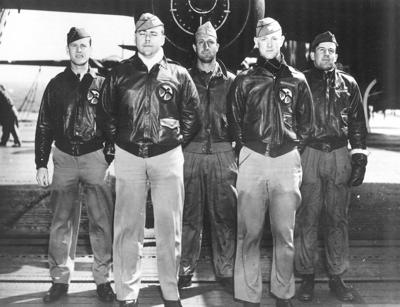Son of Doolittle Raider reflects on WWII commemorative trip to China

Pictured are the crew of the plane Griffin's father, Thomas Griffin, served on as navigator during the Doolittle Raid in World War II. Griffin is pictured farthest left.
MURRAY – On Saturday, April 18, 1942 – just four months after the attack on Pearl Harbor – a group of 80 American soldiers decided to fight back.
Led by legendary World War II pilot Jimmy Doolittle, a total of 16 Air Force planes flew off from the decks of two aircraft carriers that morning to deliver some 2,000 pounds of explosives over Tokyo.
That mission came after a long and difficult training regimen. All 79 men who volunteered had to learn how to take off with limited space, and they weren’t even told exactly what their mission was until they were ready to get in the air.
Nonetheless, the mission ended up a success. While the Americans didn’t demolish any major Japanese supply arteries or eliminate particularly high-value targets, that wasn’t the goal.
The goal was to get America back in the fight.
“The real damage done to Japan was psychological,” said Murray’s John Griffin. His father, Thomas, was a navigator on a plane in that fleet, a group that is now known as the Doolittle Tokyo Raiders. “The Japanese thought they would never be invaded. They were absolutely rolling everything in front of them in the Pacific, and they thought themselves invincible. Now in broad daylight, planes are bombing their cities.”
John Griffin is a member of the Children of the Doolittle Raiders, an organization dedicated to preserving the legacy of those 80 men while educating the public about them and providing educational scholarships.
Last month, he joined 23 others on a trip to China, where many of the raiders ended up after their mission was complete.
“The intent was never to return to those aircraft carriers,” Griffin said. “Fifteen planes went to China and one flew to Russia because it was low on fuel.”
That last plane was the only one to land peacefully; the others crash-landed while crews bailed out. Seventy-seven out of 80 men survived the initial mission. Eight were captured by the Japanese army in China, and three of those were later executed. Griffin said a fourth died of malnutrition as a prisoner of war. The crew that landed in the Soviet Union was interned for over a year, though they were later allowed to escape.
The rest, Griffin said, were scattered all over China, with many finding themselves far away from major cities.
“The planes that went the farthest got in some high mountains,” Griffin said. “Think of the Appalachians, but far steeper. When they bailed out, they were on the other side of nowhere.”
Despite the overwhelming odds, the surviving crews eventually reconnected and most even returned to fight in the war once more. Thomas Griffin would go on to participate in more bombing runs before he was shot down in 1943 and became a German POW until ‘45, though he would return home when the war ended. He lived to be 96, dying in 2013.
None of that could have been possible without the help of the Chinese people, which Griffin said took in the Americans, including his father.
“In one area where one of the crews had bailed out, a navigator had been rescued by farmers,” Griffin said. “They took him down to their farmstead and cared for him about a week.”
“We went back there on the trip and his (the raider’s) daughter was there. Arrangements had been made to meet a fellow who was a young boy and remembered when the father came through,” Griffin continued. “This guy’s father was the one who brought the raider down to the farmstead and helped take care of him. They couldn’t speak to each other, but there were translators (one of which was Murray State University professor emeritus of history Dr. Charlotte Beahan.) It was quite moving.”
Griffin said the group, which represented 10 raider families, also visited the clinic where raider Ted Lawson’s infected leg was amputated after the mission. You may recognize that name; Lawson went on to write a book on the mission, “Thirty Seconds Over Tokyo.” It later became a movie.
“That clinic is now a memorial to the ‘30s and ‘40s and the war,” Griffin said.
While he had previously been to China in 2005 on a commemorative trip with his father, Griffin said he was blown away by the hospitality his group received last month’s visit.
“Everywhere we went, we were met with friendship,” Griffin said. “Even the children had followed us around. They were fascinated by us and our stories. It was heartwarming to see.”
Griffin also noted how well China’s people remembered the raiders, despite their having been there more than 70 years ago.
“Some of these little villages and towns had created memorials to the Doolittle Raiders,” Griffin said. “It’s kind of dismaying to think that Americans are not quite as familiar with the raid as the Chinese are. It’s very important to their being able to fight off and defeat the Japanese. Without the Flying Tigers (the First American Volunteer Group of the Chinese Air Force that flew from 1941-42), the Doolittle Raid and other American assistance...modern history depended a great deal on that small but very meaningful American assistance.”
Griffin and the Children of the Doolittle Raiders also visited Beijing and saw the Great Wall, Tiananmen Square and The Forbidden City. He said they also went to a World War II museum and an air raid shelter and cave in the city of Quzhou, where several of the raiders hid out after landing in China.
“The most impressive thing to me is how much the Chinese remember this and keep the history in front of themselves,” he said.